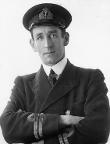(1888-) Naval Commander, expeditionist, author, editor, dramatist, journalist, radio broadcaster, businessman.
The son of Irish writer, literary figure and translator, Thomas William Hazen Rolleston (1854-1920) and his first wife Edith Caroline (nee De Burgh, 1854-), Charles Henry Rolleston was born in Upper Kindlestown, near Greystones, County Wicklow, Ireland. Sometime after completing his education he joined the Royal Navy and by the outbreak of World War I was commissioned as a Lieutenant. He later rose to captain and eventually retired in 1920 as a Commander. During the war Rolleston served aboard the H.M.S. Collingwood, and was involved in the Battle of Jutland (1916), along with turret officer Prince Albert (1895-1952), later King George VI. Later in the war he was assigned to the H.M.S. Renown. A number of newspaper reports from 1919 also record that Rolleston was the inventor of a system of wireless communication between naval units and seaplanes, which the Admiralty adopted early in the war (see note below)
Rolleston retired from the Royal Navy in 1920 and settled in Australia, where at least one of his brothers, journalist H. C. Rolleston had been living prior to the war. In late-October that same year he sailed from Sydney to Rebaul to join with other members of a British scientific expedition seeking to explore the former German territory of New Guinea ('Personal.' Warwick Daily News 21 Oct. 1920, p.2). Rolleston was also involved in editing and compiling H.M.S. Renown in Australasia (1920), an account of the battle cruiser's visit to Australia and New Zealand earlier that year with the Prince of Wales. The book, which includes contributions from most of the ship's officers, was published in Sydney by the Australasian Publishing Company.
Over the course of the 1920s Rolleston established a reputation as a prolific writer of articles and correspondence to various newspaper editors, and demonstrating a prodigious knowledge of naval and military matters. In 1923, for example, his article 'Our Sea Defence: Is Singapore the Solution? – Naval man's Criticism' was widely published around the country (see, for example Sun 29 June 1923, p.13). His correspondence in relation to military issues was often undertaken through his position as Secretary of the British Services Association. In 1921 he also took over the role of editor for the Association's journal, Austral Briton. Among other non-military topics was the subject of ocean piers, an issue that coincided with his involvement as a co-director and Secretary of Australian Piers Ltd (1924), and later with Coogee Ocean Pie Company, Ltd, which bought out Australian Piers in 1925. The objective of both companies was to build an English-style pier at Coogee Beach in Sydney.
From 1926 Rolleston branched out into radio, initially presenting a 15 minute talk for 2GB each Wednesday on ocean piers. He maintained his association with Australian radio through until 1934, becoming well-known for his lectures on the Royal Navy during WWI (including the Battle of Jutland), on British and Australian naval history in general, and on the merchant service. Rolleston did not confine himself to these subjects, however. One talk in 1933, for example, was titled 'Around the Mediterranean on Sixpence a day – Trieste and Veldes.'" (2FC 13 April). He was also cast in Alexander Macdonald's 1928 silent film, The Unsleeping Eye, alongside Charles Norman, David Wallace, Wendy Osborne and Mayne Lynton. The film was released in 1937 as a sound film.
Before leaving Australia sometime around 1934/1935, Rolleston continued to expand his range of topics, both for radio and the press, drawing on his travels and life experience to contribute articles like 'Some Irish Writers: The Literary Renaissance' (Sydney Morning Herald 7 July 1934, p.11) and 'Malta: Island of Sunshine,' for the Australasian column, 'The Tourist' (15 September 1934, p.44).
Among his final works to be presented before the Australian public were a radio play, Nelson and a stage play, The Quern. The first work, written entirely by Rolleston, focuses on the battle of Trafalgar. It was produced by the Australian Broadcasting Commission to celebrate the battle's 1933 anniversary. The following year he and Edith Sterling Levis collaborated on The Quern, a Celtic 'phantasy' that draws on each author's knowledge of Irish folklore. The play was first staged at Sydney's Savoy Theatre. The following year it reached the finals of the International one-act Play competition held in London. For that competition it was re-named, The Spellbound. The play was revived in Sydney in 1937 under its original title.
While little is known of Rolleston's life and career after returning to Britain, he is recorded as having published Portrait of an Irishman: A Biographical Sketch of T. W. Rolleston (1939). He also founded the Listener's Association in 1948 as a means of drawing public attention to objectionable trends in BBC broadcasts ('The Past Had a Champion' Sun 13 Aug. 1950, p.21).
 3288797824655071309.png
3288797824655071309.png
 3288797824655071309.png
3288797824655071309.png